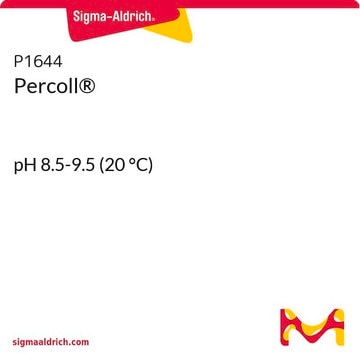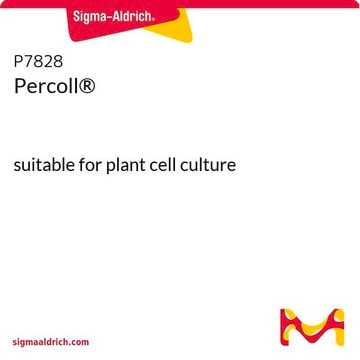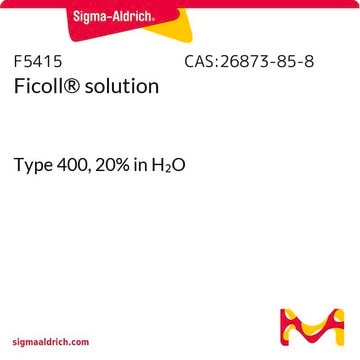Percoll and Percoll Plus are manufactured by Cytiva. The Product Information Sheet for this product provides a basic protocol and references for common cell types. Additional references and mathematical models can be found on the Cytiva website.
Typically, references identify a specific density for each cell type or molecule of interest. Instructions for preparing a specific density are included in the product information sheet or a similar document on the Cytiva website. The references will mention the G force to be used, as it accurately defines the centrifuge conditions. If revolutions per minute (RPM) is stated, the radius of the centrifuge affects the outcome. Nomogram tables are available for converting G force to RPM. To find a nomogram table, search for "nomogram" in the document titled "Centrifugal Filters: Guide to Converting g-Force to RPM." Instructions for use are included to convert G force to the appropriate RPM setting for a specific centrifuge.
P4937
Percoll®
pH 8.5-9.5 (25 °C), suitable for cell culture
Synonym(s):
Density gradient medium
About This Item
Recommended Products
sterility
aseptically filled
Quality Level
technique(s)
cell culture | mammalian: suitable
single cell analysis: suitable
pH
8.5-9.5 (25 °C)
density
1.13 g/mL±0.005 g/mL at 25 °C (lit.)
storage temp.
2-8°C
Looking for similar products? Visit Product Comparison Guide
General description
Application
Features and Benefits
- Low osmolality permits precise adjustment to physiological conditions without significant interference from the medium.
- Compatible with living cells and viruses and allows separation and recovery of intact, fully active systems.
- Impermeable to biological membranes, resulting in no change of buoyant density of particles during centrifugation.
- Spontaneous formation of gradient during centrifugation allows mixing of large sample volumes in the centrifuge tubes.
- Low viscosity results in rapid formation of gradients and particle separation.
- Most biological particles having sedimentation coefficient values greater than 60S can be successfully isolated in Percoll gradients.
Legal Information
related product
Storage Class Code
12 - Non Combustible Liquids
WGK
nwg
Flash Point(F)
Not applicable
Flash Point(C)
Not applicable
Personal Protective Equipment
Choose from one of the most recent versions:
Certificates of Analysis (COA)
Don't see the Right Version?
If you require a particular version, you can look up a specific certificate by the Lot or Batch number.
Already Own This Product?
Find documentation for the products that you have recently purchased in the Document Library.
Customers Also Viewed
Protocols
To prepare a Percoll gradient, the osmolality of Percoll must be adjusted with saline or cell culture medium to make Percoll isotonic with physiological salt solutions.
To prepare a Percoll gradient, the osmolality of Percoll must be adjusted with saline or cell culture medium to make Percoll isotonic with physiological salt solutions.
To prepare a Percoll gradient, the osmolality of Percoll must be adjusted with saline or cell culture medium to make Percoll isotonic with physiological salt solutions.
To prepare a Percoll gradient, the osmolality of Percoll must be adjusted with saline or cell culture medium to make Percoll isotonic with physiological salt solutions.
-
Further to the above question: "When using Product P1644, Percoll®, what density should I use for my particular system?", when I review the sheet for granulocytes and RBCs it gives a centrifugation speed as "*" . What does this mean?
1 answer-
Helpful?
-
-
What is the difference between Percoll® Products P4937 and P1644?
1 answer-
Product Nos. P1644 and P4937 are both Percoll. Product No. P4937 has additional testing for use in cell culture.
Helpful?
-
-
When using Product P1644, Percoll®, what density should I use for my particular system?
1 answer-
The product information sheet (under Documents, above) has a table of densities for different organelles and cell types.
Helpful?
-
-
What is the Department of Transportation shipping information for this product?
1 answer-
Transportation information can be found in Section 14 of the product's (M)SDS.To access the shipping information for this material, use the link on the product detail page for the product.
Helpful?
-
-
Is there a "best" salt solution to use with Product P1644, Percoll®?
1 answer-
Percoll can be used with various salt formulations (PBS, 1.5 M NaCl, HBSS, etc.). Physiological saline and balanced salt solutions can be suggested. Sucrose is included to prevent aggregation. You can find detailed preparation instructions on the product information sheet (under Documents, above) for this product.
Helpful?
-
-
Can Percoll®, Product P1644, be autoclaved?
1 answer-
Percoll can be autoclaved, but this must be done without any salts or sucrose present.
Helpful?
-
-
Can you help me calculate gradients for Percoll®, Product P1644?
1 answer-
The product information sheet (under Documents, above) has an equation for calculating density of a given solution.
Helpful?
-
Active Filters
Our team of scientists has experience in all areas of research including Life Science, Material Science, Chemical Synthesis, Chromatography, Analytical and many others.
Contact Technical Service











